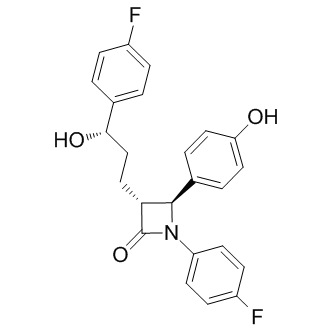| Cas No.: | 163222-33-1 |
| Chemical Name: | Zetia , Ezetrol |
| Synonyms: | Zetia , Ezetrol |
| SMILES: | O=C1N(C2=CC=C(F)C=C2)[C@H](C3=CC=C(O)C=C3)[C@H]1CC[C@H](O)C4=CC=C(F)C=C4 |
| Formula: | C24H21F2NO3 |
| M.Wt: | 409.4 |
| Sotrage: | 2 years -20°C Powder, 2 weeks 4°C in DMSO, 6 months -80°C in DMSO |
| Description: | Ezetimibe (SCH 58235) is a Niemann-Pick C1-like1 (NPC1L1) inhibitor, and is a potent Nrf2 activator. Ezetimibe (SCH 58235) is a potent cholesterol absorption inhibitor. |
| In Vivo: | Administration of Ezetimibe (Eze) reduces the liver weights of mice fed the methionine- and choline-deficient (MCD) diet. This is consistent with the beneficial effects of Ezetimibe on hepatic steatosis. Liver histology shows pronounced multiple macrovesicular fat droplets in mice on the MCD diet, but Ezetimibe treatment markedly decreases the number and size of those droplets. Furthermore, hepatic fibrosis in mice fed the MCD diet is significantly attenuated by Ezetimibe[1]. Blood and liver lipid levels including TG, free fatty acids (FFA), and total cholesterol (TC) are significantly decreased in Ezetimibe-treated OLETF rats. Moreover, OLETF rats show higher serum levels of glucose, insulin, HOMA-IR, TG, FFA, and TC than LETF animals, which are significantly reduced by Ezetimibe. In addition, histological analysis indicated that OLETF control rats showed larger lipid droplets in hepatocytes than age-matched LETO controls, which are attenuated by administration of Ezetimibe[2]. |
| In Vitro: | Ezetimibe (Eze) acts as a potent Nrf2 activator without causing cytotoxicity. Ezetimibe enhances transactivation of Nrf2, as revealed by a luciferase reporter assay. Ezetimibe also upregulates Nrf2 target genes, including GSTA1, heme oxygenase-1 (HO-1) and Nqo-1 in Hepa1c1c7 and MEF cells. Ezetimibe upregulates Nrf2 target genes in Nrf2+/+ MEF cells, whereas this induction is totally blocked in Nrf2-/- MEF cells. Taken together, Ezetimibe acts as a novel Nrf2 inducer in a ROS-independent manner[1]. Human huh7 hepatocytes are pretreated with Ezetimibe (10 μM, 1 h) and incubated with palmitic acid (PA, 0.5 mM, 24 h) to induce hepatic steatosis. Ezetimibe treatment significantly attenuates PA-increased triglycerides (TG) levels, which is consistent with our animal study. PA treatment resulted in an approximately 20% decrease in mRNA expression of ATG5, ATG6, and ATG7, which had been increased by Ezetimibe treatment. In addition, Ezetimibe treatment significantly increased the PA-induced reduction in LC3 protein abundance[2]. |

 DC Chemicals' products qualify for U.S. tariff exemptions. We guarantee no price increases due to customs duties and maintain stable supply, continuing to deliver reliable research solutions to our American clients.
DC Chemicals' products qualify for U.S. tariff exemptions. We guarantee no price increases due to customs duties and maintain stable supply, continuing to deliver reliable research solutions to our American clients.





















